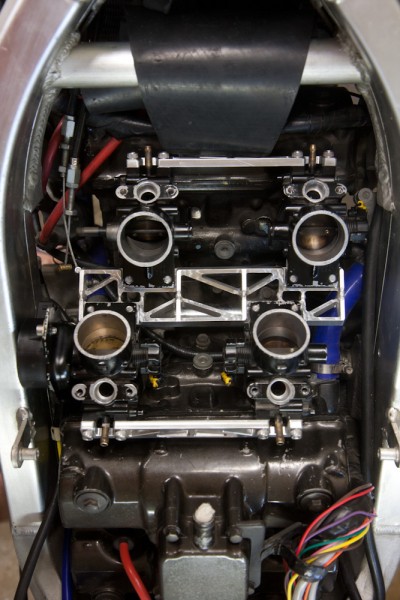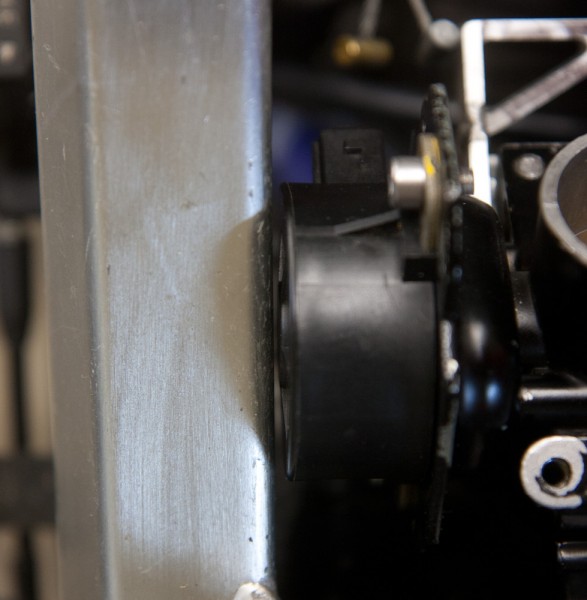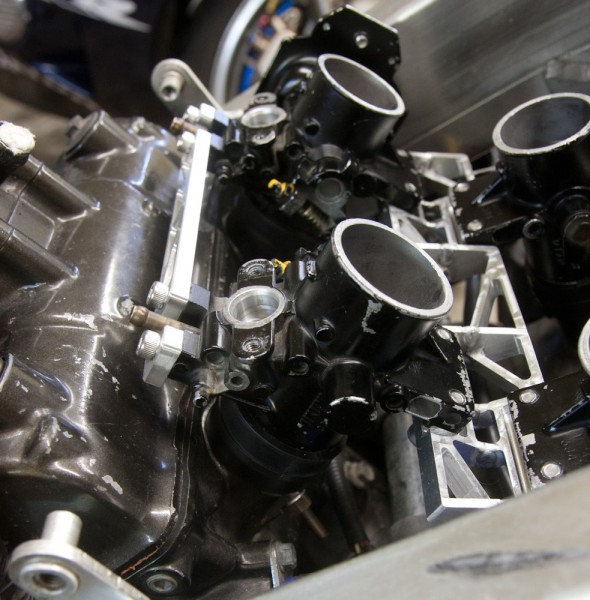With the intake rubber fitment problem overcome, I could finally mount the entire throttle body assembly onto the bike. This was a moment long coming.

The throttle body assembly, without airbox and fuel rail, test fitted onto the engine. Thankfully everything fit perfectly.
Thankfully it all fit. The four throttle bodies slid into the intakes a lot easier than the carbs did, which isn’t surprising since the “barbs” are much smaller now. The tightest spot by far is the throttle position sensor.

There’s about a mm between the throttle position sensor cover and the frame. I had paid close attention to whether this would fit and concluded that it would, but I’m not sure I realized it would be that close.
The position of the throttle cable attachment also looks like it will work unmodified. It’s a bit lower than it is on the carbs (because the throttle butterflies turn the opposite way) but I could hook it in to the existing cable and move the handle and have it work. I think the handle travel to full throttle will end up being a bit less than with the carbs.
After further mounting the fuel rails and the airbox, I could verify that there’s also no interference between the other tight spots: the connector fuel hose on the #1 cylinder and the manifold pressure port on the fuel pressure regulator are close to the inside of the fuel tank, but not touching. The fuel supply hose at the #4 cylinder clears the frame crossmember in front of it and loops under the cylinders.
With the whole throttle body assembly mounted, I could proceed to wire up the fuel injectors. These are supplied with +12V from the fuse box and are grounded by the Microsquirt injector outputs. Since there are only two outputs, the front and back cylinder injector pairs are wired to the same outputs.
That was a fairly minor wiring job and after that was done, it was theoretically possible to start the bike. There are no throttle linkages, of course, so all the throttle butterflies are closed and it would only pull air through the small ports on top of each of the throttle bodies, but this should be sufficient to get it to idle.
With the fuel pump pulling out of the gas can like it did for the fuel injector measurements, I fired up TunerStudio, connected to the Microsquirt, and hit the starter.
Ignition!
It fired almost immediately and settled into a very high idle. It’s clearly getting too much air through those little air ports to have a reasonable idle that way.
Here’s a video of this momentous occasion:
So there we go, there’s hope!
There are a few options for the idle. One is to use the carb method and crack the throttle valves a tiny bit. That’ll work, but it’s very sensitive. Another option is to connect all four of the air inlet ports and use some sort of restriction (ideally adjustable) to set the idle speed. The third, and most advanced and flexible, is to use an electrically actuated valve to set the idle speed. With this option you can program the Microsquirt to do things like raise the idle when cold, so it won’t stall under those conditions. This would be useful, but that would also require fitting more hardware under the engine. I’ll ponder this while I work on the fuel plumbing.

It’s great to see/hear the bike running.
I notice you’ve got the NC30 idling at 29 degrees BTDC. On my GSF400 project I found that 10 degrees BTDC was perfect for a 1,300 RPM idle (which was a bit of a surprise because the stock ignition idle advance for the bike was 15 degrees BTDC), but the bike idles there quite happily and has excellent off-idle performance.
I see in my PDF copy of the NC30 service manual that the specification for idle at 1,200 RPM is 18 degrees BTDC, so it seems your bike might need a bit more advance at idle than my GSF400 does.
Very observant. It actually *idles* at ~15 degrees, it’s just that now it’s getting too much air. The ignition starts advancing at 2000rpm, so it’s already already kicked in the way it runs now.
Sorry, made an overreaching assumption there. With the current air input situation being unknown I figured you’d be running the ignition in the “fixed timing” setting rather than “use table”.
No, the ignition runs the stock ignition timing. I already tested the ignition part before I took the carbs off, so I know that part’s good.
Pingback: Microsquirting the NC30, part #27: Idle Air Controller – Patrik's projects